
The Noctuidae, commonly known as owlet moths, cutworms or armyworms, are a family of moths. They are considered the most controversial family in the superfamily Noctuoidea because many of the clades are constantly changing, along with the other families of the Noctuoidea. It was considered the largest family in Lepidoptera for a long time, but after regrouping Lymantriinae, Catocalinae and Calpinae within the family Erebidae, the latter holds this title now. Currently, Noctuidae is the second largest family in Noctuoidea, with about 1,089 genera and 11,772 species. This classification is still contingent, as more changes continue to appear between Noctuidae and Erebidae.

The Lymantriinae are a subfamily of moths of the family Erebidae. The taxon was erected by George Hampson in 1893.

The yellow-tail, goldtail moth or swan moth is a moth of the family Erebidae. The species was first described by Johann Kaspar Füssli in 1775, and has commonly been placed within the related genus Euproctis. It is distributed throughout Europe to the Urals, then east across the Palearctic to Siberia and south to India and Sri Lanka.

Arctia menetriesii, the Menetries' tiger moth, is a species of tiger moth in the family Erebidae. It was first described by Eduard Friedrich Eversmann in 1846. It is found in Karelia, Oktyabrskoe, northeastern Kazakhstan, Altai Mountains, Sayan Mountains, Evenkia, Yakutia, the central Amur region, Primorsky Krai and central Sakhalin. It was believed to be extinct in Fennoscandia, but the species has been recently recorded in Finland. This species is characterized by the fact that they never come to light; such behavior is atypical in the family Arctiidae.

Wittia sororcula, the orange footman, is a species of moth in the family Erebidae. The species was first described by Johann Siegfried Hufnagel in 1766. It is found in Europe, Anatolia and further east across the Palearctic to southern Siberia and the Amur basin to China.
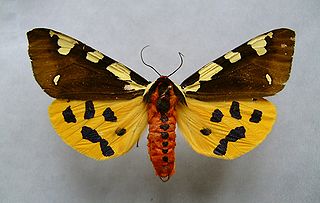
Arctia is species of tiger moth in the family Erebidae. It was first described by Carl Linnaeus in his 1758 10th edition of Systema Naturae. It can be found in central and eastern Europe, Kazakhstan, southern Siberia, northern Mongolia, Amur Region, Primorye, Sakhalin, Kunashir, northern and northeastern China, Korea and Japan.

Arctia tigrina is a moth of the family Erebidae. It is found on the Iberian Peninsula and the South of France and Italy.

Arctia aulica, the brown tiger moth, is a moth of the family Erebidae. The species was first described by Carl Linnaeus in his 1758 10th edition of Systema Naturae.

Zanclognatha is a genus of litter moths of the family Erebidae. The genus was erected by Julius Lederer in 1857.
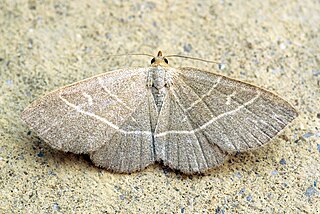
Trisateles is a monotypic moth genus of the family Erebidae described by Tams in 1939. Its only species, Trisateles emortualis, the olive crescent, was first described by Michael Denis and Ignaz Schiffermüller in 1775. It is found in most of Europe, east to Siberia, northern Iran and China.
Clethrogyna is a genus of tussock moths in the family Erebidae. The genus was described by Rambur in 1866.
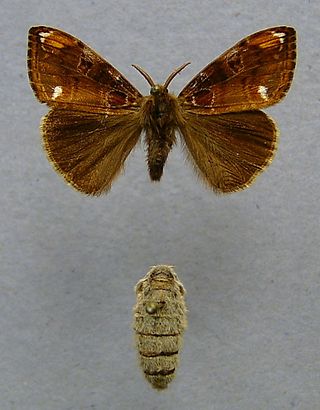
Telochurus recens, the scarce vapourer, is a moth of the subfamily Lymantriinae found in Europe. The species was first described by Jacob Hübner in 1819. The wingspan is 35 to 40 millimetres (1.4–1.6 in) for the males; the females are wingless. The moth flies from June to July depending on the location. The larvae feed on various deciduous trees, such as Crataegus and Salix species. This species has commonly been placed in the genus Orgyia but molecular analyses support its exclusion from that genus, and placement in the genus Telochurus.
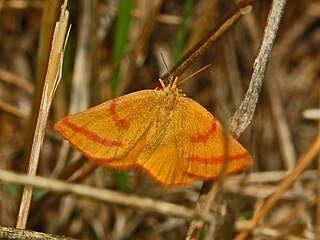
Lythria purpuraria, the purple-barred yellow, is a species of moth of the family Geometridae. It is found from western Europe to Siberia, Russia, Ukraine, Turkmenistan and Kazakhstan.

Carriola ecnomoda is a moth of the family Erebidae first described by Charles Swinhoe in 1907. It is found south-eastern Asia, Sundaland and the Philippines. In 2015, the genus Carriola was synonymized with Arctornis by Wang et al., but subsequently revised in 2024 by Shovkoon & Trofimova.

Calyptra thalictri is a moth of the family Erebidae. It is native to the area ranging from Japan and Korea to China and Malaysia, west through the Urals to Southern Europe, but it has recently expanded its range to northern Europe. In 2000, it was observed in Finland and in 2008 it was recorded even further west, in Sweden.

Clethrogyna aurolimbata is a species of moth of the family Erebidae first described by Achille Guenée in 1835. It is found in the Pyrenees and on the Iberian Peninsula. The larvae feed on Genista species, including Genista purgans. This species has commonly been placed in the genus Orgyia but molecular analyses support the genus Clethrogyna as a separate lineage.
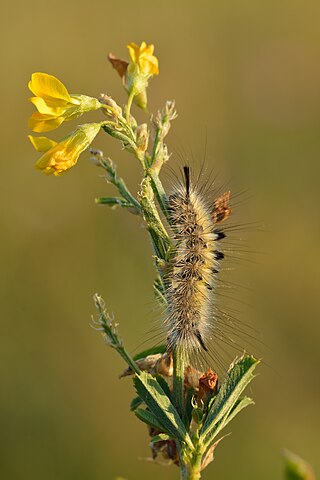
Gynaephora selenitica is a moth in the family Erebidae first described by Eugenius Johann Christoph Esper in 1789. It is found from central Europe through eastern Europe to the Urals and Ob' River in West Siberia. It is not found in western and southern Europe and Scandinavia.

Arctia testudinaria, or Patton's tiger, is a moth of the family Erebidae. It was described by Geoffroy in 1785. It is found from northern Spain to southern and central France and southern Switzerland to north-eastern and southern Italy. It has also been recorded from Great Britain. The habitat consists of grasslands, slopes, forest edges, clear dry forests, cliffs and mountain slopes, maquis, garrigues and dry meadows.
Chelis brucei, or Bruce's tiger moth, is a moth of the family Erebidae. It was described by Henry Edwards in 1888. It is found in western North America in the northern Cascade Mountains, the southern British Columbia Coast Range, the mountains of Vancouver Island and the Rocky Mountains of Colorado and Wyoming.

Diacrisia metelkana is a moth in the family Erebidae. It was described by Julius Lederer in 1861. It is found in southern and central Europe, Russia, eastern Asia and Japan.



















